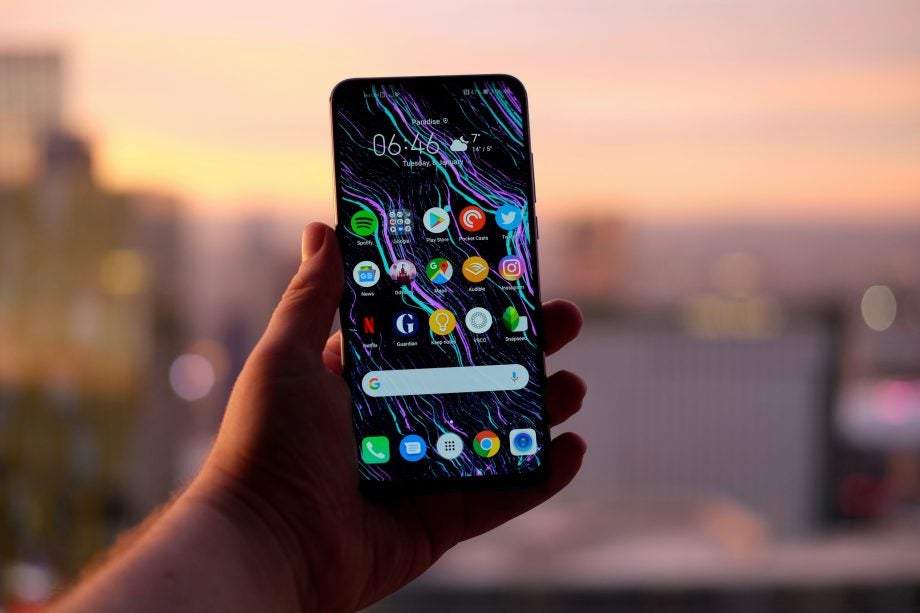Honor View 20 Review
Honor View 20 Review
A new era for phone design

Verdict
With flagship phones becoming more expensive – no one is expecting the upcoming Galaxy S10 to come at a price that’s anywhere close to this – the View 20 is the ideal antidote.
Pros
- New screen design looks great and deals with the notch issue
- Good battery life and very fast charging
- A headphone jack
- Very capable camera
Cons
- Strange performance quirks
- Software still needs work
- No wireless charging or IP rating
Key Specifications
- Review Price: £499
- 6.4-inch 1080p display
- 48-megapixel camera
- 6/8GB RAM
- 128/256GB storage
- 4000mAh battery, USB-C
- Android 9 Pie
- Kirin 980
What is the Honor View 20?
Honor’s usual wheelhouse is budget phones that punch above their weight. The Honor View 20 is a different proposition, however: what can Honor achieve if it goes all-out with top-end tech and high-end specs and can it compete with the Samsung Galaxy S10, Nokia 9, Huawei P30 Pro?
Honor has designed “flagships” before – the View 10 and Honor 10 spring to mind – but nothing quite like this. In the View 20, the company combines a 48-megapixel camera, 4000mAh battery, 6.4-inch display and the ultra-fast Kirin 980 processor. All for £499.
Related: Honor 20 Pro review
Editor’s Note: Due to the recent retraction of Huawei’s Android license, future Huawei and Honor phones won’t be able to access Google Play Services and as a result many Android apps including YouTube and Gmail. Both Huawei and Google have confirmed Huawei and Honor phones, like the one in this review, will continue to have access for this time being. Until we know more about the situation we’re leaving the scores on all our Huawei reviews, however as the situation changes we’ll revisit this.
Honor View 20 – Design
I wouldn’t consider 2018 a strong year for phone design. The difficulties served up by the notched-screen lead to a mishmash of styles, all of which mostly felt like compromise.
Honor previously attempted to steer away from the notch with the Magic 2 (available only in China). This device’s design employed a sliding body to hide the front camera when not in use. Moving onwards, that device has been replaced for the View 20 – and the results are noticeably better.

Instead of a notch cut-out a third of the way along the screen’s top edge, or hiding away sensors, cameras and microphones, the View 20 features a single, much smaller hole punched into the top-left corner of the device. It’s where the 25-megapixel selfie camera resides, with the microphone sitting in a tiny lip above the display.
It’s a clever solution – one that will likely be replicated numerous times in the coming months, most obviously by the Samsung Galaxy S10 – since it gives a bezel-less look without affecting device usability. Yes, a small chin remains at the bottom of the handset but this is commonplace with phones such as this.
Honor’s thoughtful design continues around the rear of the device as well. Here you’ll see a glass covering, whose laser-etched “V” pattern beneath catches the light and reflects beautifully. Sitting between the glass rear and front is a rigid metal rim, adding a sturdy finish.
Impressively, there’s enough space here for both a headphone jack (a rarity in 2018, let alone 2019) and an IR blaster for controlling a television. The Honor View 20 lacks any official water-resistance, though. It also foregoes QI wireless charging, something you’d expect to see supported given the phone’s glass back. I assume this was omitted to ensure the View 20 remains as affordable as possible.
Related: Best wireless charger

What I like most about the design, however, is just how narrow and easy the phone is to hold. The curved sides slip comfortably into your hand, while most things can be done one-handed. Yes, reaching right to the corners is difficult, but the device doesn’t feel at all cumbersome in the way of the iPhone XS Max or Google Pixel 3 XL.
Honor View 20 – Screen
Taking up an impressive 91% (or 91.82%, if you want to be precise) of the front of the Honor View 20, the 6.4-inch display stretches out from almost corner to corner without a notch to distract your view. The only interruption is the small black spot that is the front camera. It looks great.
The display quality itself is decent, too; comfortably competing with similarly priced phones. Honor’s opted for an LCD panel over OLED, which means blacks aren’t quite as deep and colours don’t offer quite the same pop as those on the OnePlus 6T. The likely reason for sticking with LCD was the lack of OLED panels with this hole-punch camera (Samsung makes one, but that’s likely being kept for the Galaxy S10) and, of course, the general extra cost associated with OLED.
Still, it’s an attractive display: crisp, colourful and, most importantly, bright. The 1080p resolution is more than sufficient to ensure individual pixels won’t be seen, and while there’s no HDR (high dynamic range) support, media still has good definition between colours.

Honor does have a tendency to unnaturally boost colours slightly, and by default, the screen is set to Vivid mode. Head into Settings to fiddle with the colour temperature, making things warmer or cooler, or even tweaking further with a colour temperature wheel is advised for more accurate viewing, at lest in theory.
While it may appear that you have a good degree of control here, none of my tweaks made a positive difference. Even switching from Vivid mode to Normal just left everything feeling a little flat.
Honor has done a good job of ensuring the camera cut-out doesn’t really get in the way. Icons in the top-left corner have been moved to the right slightly, and if you’re using a dark wallpaper then it blends seamlessly. Obviously, on a page with a white background, the cutout will be more prominent. Video apps tend to deal with it in the same way they would a notch: you can expand YouTube, while Netflix covers it with a black bar.
Honor View 20 – Performance
The Honor View 20 includes all the components to be up there with the iPhone XS and Huawei Mate 20 Pro in performance terms. Like Huawei’s latest phones, the View 20 uses the Kirin 980 SoC (system-on-chip), which is built using a super-efficient 7nm manufacturing process. This allows for better performance without sacrificing battery life.
Alongside this high-powered chip is plenty of RAM (6 or 8GB depending on region) plus two storage options: 128GB or 256GB. Top of the line in pretty much every area, then.
Honor has also used some of its own software smarts to try to push the performance even further. The GPU Turbo feature initially introduced on a more budget phone, pushes performance when gaming, especially in titles such as PUBG and Asphalt 9. Arguably this feature is more a requisite for less-powerful phones, where that extra boost will be more obvious. The View 20’s gaming prowess is impressive anyway.
Even though the Honor View 20 is generally a pretty fast phone, the fact that it’s so snappy makes the frequent performance oddities more visibly jarring. You’ll encounter slow animations everywhere, especially when jumping back from an app to the home screen, or into the multitasking view. I had no such issues on the Huawei Mate 20 Pro – which uses the same Kirin 980 – so it seems that Honor hasn’t optimised its EMUI software quite so well here.
Of course, this does mean that such issues could easily be fixed down the line.

The generous amount of RAM (8GB on the model reviewed here and 6GB on other devices) means apps stay in memory for a long time without forcibly reloading. Alto’s Odyssey, for instance, remained from my morning commute to the evening. You’ll also find that you can quickly jump between apps without losing your spot.
Honor says there’s some extra cooling provided inside. Nine Cooling Tech, to give it its “proper” name, includes a heat pipe along with coolant. Honor says this pipe touches upon the main internal components of the phone (camera, CPU, battery and so on) then along to the sides for releasing heat. It’s hard to really judge how well this works, since most phones can handle heat pretty well these days. Nevertheless, during charging and extended bouts of 3D gaming, the phone didn’t get hot.
While having a headphone jack is a nice touch, and likely to be a rarity among other 2019 flagships, I do wish that general audio was better. Sound is tinny and the single, downward speaker can only be described as terrible. Its position means that it’s all too easily blocked whilst playing a game and the lack of stereo separation leaves media feeling flat.
Another duo of features touted heavily by Honor is triple-antenna Wi-Fi and dual-frequency GPS. Both should offer more reliable connections, whether you’re navigating in Google Maps or downloading a movie from Google Play. Surprisingly, I actually found the Wi-Fi connection weaker than both an iPhone XS and Google Pixel 3 XL. Both of these phones registered noticeably faster download speeds and were quicker at downloading a 1GB file. However, the View 20’s GPS was impressive; even when navigating around London, with its landscape of tall, close-knit buildings, the signal remained strong and accurate.

There are two SIM slots inside the View 20, both of which fully support 4G data and calls. Once a main SIM is set – you can set one SIM for calling and the other for data – it’s easy to switch between the two too. Having dual-SIM functionality is great if you travel often, or want to use the phone for both work and personal use. Mobile payments are taken care of thanks to NFC.
Honor View 20 – Software
Aside from the optimisation issues already mentioned, the software here mirrors closely what you’ll find on any current Huawei flagship. The EMUI (Emotion UI)/ Magic UI skin used over the top of Android 9 Pie is about as heavy as they come, overwriting just about every aspect of Google’s OS.
EMUI has come a long way in the past few iterations, however. Operation is smoother; there’s less need for you to faff with a multitude of non-sensical menu options; and some of the UI elements aren’t quite so borked. For example, the audio controls finally display on the lock-screen without half of the contents being cut off.
Yet EMUI’s constant desire to mimic iOS functions and design elements leave it feeling cheap and seriously behind other software layers from the like of Samsung and Google. Everything from the share panel that pops when you try to send a photo to the native apps feel like they’re knock-off iOS.
This is a shame, because there’s a lot of powerful functionality on offer. Honor phones have one of the slickest and most customisable battery-saver modes, giving you in-depth control when you want to stretch the already excellent battery even further.

There’s support for Themes (although I’d say the choices are all fairly “meh”), an accurate – if not overly secure – facial unlocking feature, and the option of splitting certain apps such as Facebook and WhatsApp into two distinct versions. These are things you just can’t do on stock Android.
Honor has also tweaked the usual array of soft-keys you’ll find at the bottom of the display. By default, you’ll find the typical Back, Overview and Home controls, but you can switch to a gesture-based system that’s similar to that found on the iPhone XS. I much prefer this method to Google’s odd system of swipes and taps introduced in Android Pie, and once you get used to the slightly irritating Back gesture (the OS often thinks you’re just swiping inside an app, rather than wanting to go back), it works exceptionally well.
Honor View 20 – Camera
Even with a design so unique, the camera is still the most interesting part of the Honor View 20. It’s a feature-rich setup packed with high-end specs and an array of software tweaks. It’s a good camera, great at times, and has the potential to continue getting better.
Glance at the majority of flagships phones and you’ll find that most sport a similar number of megapixels. The iPhone XS, Samsung Galaxy S9 and Pixel 3 all have a 12-megapixel sensor; others, such as the OnePlus 6T, up that to 16. The Honor View 20 has a 48-megapixel camera.

Obviously, we’re far past the stage where simply having a greater number of megapixels equals a better camera, though, as the Huawei P20 Pro proved – it doesn’t hurt.
By default the View 20 will shoot 12-megapixel snaps, using the data from those extra megapixels to improve zoom quality and overall detail. Head to the Settings menu and you can up that to utilise all 48 megapixels. Be warned that if you do shoot in this mode, however, there’s no zooming functionality at all.
Since it is the default, and as such should be the most optimised mode, I tended to shoot consistently in this 12-megapixel mode, switching to 48-megapixels if I was shooting macro or landscape shots. Thanks to the use of a software tweak that combines the data of adjacent pixels in the sensor together (a technology known as pixel binning), you’re still essentially making use of all the megapixels – no matter which mode you shoot in.
Arguably the most interesting shooting mode offered by the View 20 is 48-megapixel “AI Ultra Clarity”. This uses the power of the neural processing unit (NPU) inside the Kirin 980 to combine multiple high-resolution snaps together, creating an HDR image.
This isn’t for everyday shooting, though, as you’re required to hold the phone steady for around five seconds and you can’t set it to always be your default – you’ll need to manually switch to this mode every time you open the camera too. For situations where the subject is still, it works very well and results in detailed photos.
I’ve been consistently happy with all the photos I’ve taken with the Honor View 20; it comfortably performs above what I’d expect at this price. Pictures are highly detailed – the one trait that stands out among all else – with decent colours and dynamic range. Colours do have a tendency to be on the cooler side, leaving you with slightly blue pictures, but this isn’t necessarily a bad thing.

Landscapes look especially good

The sky is balanced well here, with no blown highlights

Focussing is accurate even up close

Detail is rich, while colours are nicely balanced

(AI off)

(AI on)


It deals well with tough conditions

With minor editing, the snaps can look absolutely fantastic

Like previous Honor phones, there’s an AI shooting mode here that will, in theory, detect what you’re shooting and alter the settings for you. Aim at a grass-heavy landscape and the phone will boost vibrancy and saturation in the greens; focus on an intricate building and it will sharpen the resulting image to try to bring out the detail further.
Honor’s AI touches are less rigorous than Huawei’s, which I found did too much to the picture – and often I didn’t notice the changes at all. If you’re the sort of person who likes to manually edit a snap after-the-fact, I’d leave this mode disabled.
When shooting in low-light situations, the camera again combines four pixels into one, giving you a 12-megapixel shot. Having these bigger pixels allows more light into the ½-inch sensor, brightening up the resulting photo. Again, results are good; far better than a phone with such a price has any right to achieve.
Situated next to the 48-megapixel camera is a secondary, 3D ToF (time-of-flight) sensor. This sensor’s job is to improve the accuracy of 3D modelling and AR functionality, however, the sensor is used to more effectively separate a subject from the background in portrait mode shots too. Currently, many of these features are limited to the Chinese edition of this phone.
I’ve never been a huge fan of Honor’s selfie cameras. There might be 25 megapixels tucked into the small hole punched on the front but because of the degree of processing the resulting selfies still adopt an overly smoothed-out look. I’m sure there are plenty of folks who are fans of this type of finish – there has to be since it’s becoming more and more popular – but it’s not for me.
Video seems like an afterthought on the View 20. 960fps video at 720p is nice to have but it’s a pain to quickly get to since it’s separated from the rest of the video options.
Honor View 20 – Battery life
Honor (and its parent company Huawei) are leading the pack when it comes to impressive battery life on phones. Both the Huawei P20 Pro and Huawei Mate 20 Pro excelled with their stamina and the Honor View 20 stands alongside those battery behemoths.
There are a number of reasons that the endurance is so good here. First is the inclusion of that 4000mAh battery, which remains towards the high-end of what a consumer-focused phone can handle. Next is that efficient 7nm chipset and, finally, there’s only a FHD+ display to power.
Throughout my two weeks with the Honor View 20, it consistently made it through what I consider a “normal” day. I’d take the phone off charge around 7am, listen to roughly an hour of streaming audio, clock up an hour of video streaming, a bit gaming and the usual browsing and messaging. Come midnight there would still be around 15-25% charge remaining.
Make use of some of the battery-saver modes, tweak the screen resolution and temper performance, and you should see the cell stretch to two days without having to bend over backwards. Of course, battery life varies wildly depending on the user, but I’m confident no-one will be disappointed with the endurance on offer in the View 20.
For charging, you’ll find an Honor Supercharge plug in the box. This supports 5A/4.5V speeds and does a great job at quickly powering up the handset. Honor claims you’ll jump from 0-50% in 30 minutes; in my tests the View 20 wasn’t far off, taking roughly 37 minutes to get to 50% and then a further 52 minutes to reach 100%.
Why buy the Honor View 20?
It might be the first big flagship of 2019 but the Honor View 20 makes a strong case for being one of the best come the end of the year. It’s a testament to how quickly Honor is growing and improving that the company is churning out fantastic phones both in the budget and flagship space.
The Honor View 20 impresses with a great camera, forward-looking design and minimal compromises. I don’t love the software, and you’re missing features such as an IP-rating and wireless charging. However, for the price, I don’t think you can fuss. Honor clearly believes people would rather have generous amounts of storage and RAM over Qi charging, and while this isn’t my preference, I’m sure it will be for many.
Related: OnePlus 7 Pro review
Strong competition comes from the OnePlus 6T while we’re still to see what else 2019 brings. While the 6T beats the View 20 for screen quality and software experience, I’d comfortably say that the Honor impresses more in all other areas.
Verdict
With flagship phones becoming more expensive – no one is expecting the upcoming Galaxy S10 to come at a price that’s anywhere close to this – the View 20 is the ideal antidote.
How we test phones
We test every mobile phone we review thoroughly. We use industry standard tests to compare features properly and we use the phone as our main device over the review period. We’ll always tell you what we find and we never, ever, accept money to review a product.


